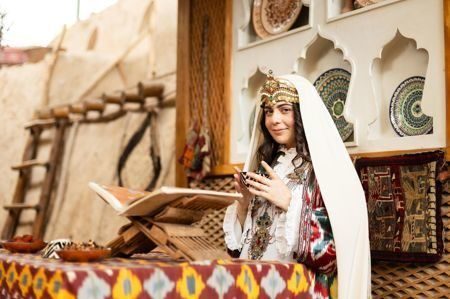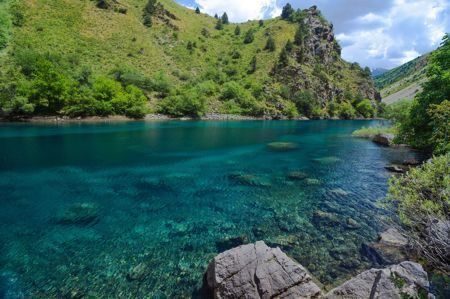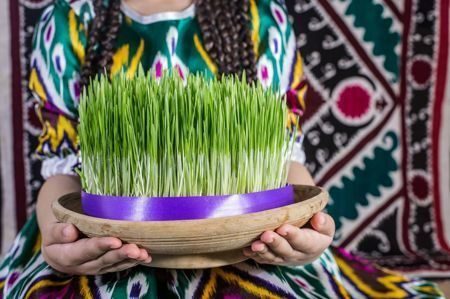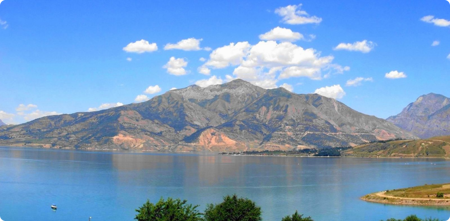
Ferghana valley-the pearl of Central Asia
The Ferghana valley is called the pearl of Central Asia for its richness and beauty. The valley is surrounded by the Tien Shan and Hissar-Alai mountains, and only in the West opens the gates to the Syr Darya river.
 The Ferghana valley has always played a significant role in the history and culture of Central Asia. Thus, reports about the Ferghana state of Davan are already contained in ancient Chinese Chronicles from the end of the II century BC, and in the middle ages it was one of the leading appanages of maveranahr. The fact that in ancient times the valley was the center of various civilizations, reminiscent of the remains of the bronze age settlements, the early iron age and monuments of the middle ages. Fifty kilometers from Ferghana is the small town of Rishtan. From the IX century BC the citizens of Rishtan have been renowned for their ceramics. For 1,100 years, masters have passed down the secrets of producing ceramic products from local varieties of red clay and glazes made from natural mineral dyes and ash from mountain plants from generation to generation. Big dishes "lagans", deep bowls "shokosa", jugs for water, vessels for milk decorated with glaze ornament "ishkor" of unforgettable turquoise and ultramarine colors, brought istarskim masters famous at many international exhibitions, decorate expositions of many museums and private collections.
The Ferghana valley has always played a significant role in the history and culture of Central Asia. Thus, reports about the Ferghana state of Davan are already contained in ancient Chinese Chronicles from the end of the II century BC, and in the middle ages it was one of the leading appanages of maveranahr. The fact that in ancient times the valley was the center of various civilizations, reminiscent of the remains of the bronze age settlements, the early iron age and monuments of the middle ages. Fifty kilometers from Ferghana is the small town of Rishtan. From the IX century BC the citizens of Rishtan have been renowned for their ceramics. For 1,100 years, masters have passed down the secrets of producing ceramic products from local varieties of red clay and glazes made from natural mineral dyes and ash from mountain plants from generation to generation. Big dishes "lagans", deep bowls "shokosa", jugs for water, vessels for milk decorated with glaze ornament "ishkor" of unforgettable turquoise and ultramarine colors, brought istarskim masters famous at many international exhibitions, decorate expositions of many museums and private collections.
 Kokand remained the main city of the Ferghana valley for a long time. In the XVIII-XIX centuries, it was the capital of the strong Kokand khanate, which extended its power to most of present-day Uzbekistan and the territory of neighboring States. Kokand was a major religious center. In the heyday of the city there were thirty five madrasahs and one hundred mosques. Unfortunately, most of them have been destroyed by time, earthquakes, and Soviet rule.
Kokand remained the main city of the Ferghana valley for a long time. In the XVIII-XIX centuries, it was the capital of the strong Kokand khanate, which extended its power to most of present-day Uzbekistan and the territory of neighboring States. Kokand was a major religious center. In the heyday of the city there were thirty five madrasahs and one hundred mosques. Unfortunately, most of them have been destroyed by time, earthquakes, and Soviet rule.
Namangan, the birthplace of the famous Uzbek poet Mashrab, occupies a special place in the ring of Ferghana cities. At the beginning of the twentieth century, Namangan was the second most populous city and the center for cotton processing in the Ferghana valley. Not far from Namangan is the city of Andijan, the birthplace of Zahiriddin Babur, the poet, author of the famous epic  "Babur-nameh", a General, statesman who conquered India and founded the Mughal Empire. By age, Andijan is one of the oldest cities in the Ferghana valley.
"Babur-nameh", a General, statesman who conquered India and founded the Mughal Empire. By age, Andijan is one of the oldest cities in the Ferghana valley.
Thirty kilometers from the modern city is located the settlement of Marhamat-the capital of the ancient state of Davan - "Ershi", famous for its fleet-footed horses. From here, such horses, as the greatest jewel, were delivered to the court of the Chinese emperors. One of the oldest cities in the Ferghana valley is the city of Kuva. The remains of urban structures of the III century BC were found on the ancient Kuva settlement.on the territory of the settlement, archaeologists studied and excavated a Buddhist temple of the VI – VIII centuries ad. the City of Ferghana is located in the South of the Ferghana valley. This is a real garden city. Huge century-old willows, plane trees, poplars, closing their crowns, turn the streets into picturesque alleys. Ferghana is a relatively young city. It was founded in 1877 near Margilan, originally called Novy Margilan, in 1907, it was renamed Mikhail Dmitrievich Skobelev, and since 1919 it was named Fergana. 55 kilometers from Ferghana is a picturesque corner of Uzbekistan – Shakhimardan ("the Lord of people"). This is a traditional holiday destination for residents of Margilan and Ferghana.
 The mild climate of the Ferghana valley and numerous mineral springs attract many tourists here. 32 km South of Ferghana in the foothills of the Alai range at an altitude of 450 m is the balneological resort "Chimion", which specializes in the treatment of diseases of the circulatory system, nervous system, movement organs, gynecological and urological diseases. A little higher on the Northern slope of the Alai range is the mountain climate resort of Hamzaabad. Not far from Namangan in the valley of the river Cartaxi balneological Spa resort "Chartak", operating on the basis of iodine-bromine mineral waters, and in the mountain spurs of the Chatkal ridge there is the valley river Mountains, with numerous recreational areas.
The mild climate of the Ferghana valley and numerous mineral springs attract many tourists here. 32 km South of Ferghana in the foothills of the Alai range at an altitude of 450 m is the balneological resort "Chimion", which specializes in the treatment of diseases of the circulatory system, nervous system, movement organs, gynecological and urological diseases. A little higher on the Northern slope of the Alai range is the mountain climate resort of Hamzaabad. Not far from Namangan in the valley of the river Cartaxi balneological Spa resort "Chartak", operating on the basis of iodine-bromine mineral waters, and in the mountain spurs of the Chatkal ridge there is the valley river Mountains, with numerous recreational areas.
Margilan
Margilan is one of the oldest trading cities in the Ferghana valley
One of the oldest cities in Central Asia is Margilan. Margilan turned 2000 years old in 2007. In the XI century, Margilan was the largest city of the Ferghana oasis, famous for its silk fabrics, which merchants exported to Egypt and Greece, Baghdad, Khorasan and Kashgar along the great silk road. Even today, Margilan can be called the silk capital of Uzbekistan. It produces the famous "Khan-atlases", hand-woven and painted according to ancient technology.
For the first time Margilan is mentioned in written sources of the X century. This is one of the oldest trading cities in the Ferghana valley.it was well known not only among the rich agricultural oases of Central Asia, but also outside the region.Ancient Chinese written sources mention the state of Davan, which occupied the territory of the Ferghana valley (III century BC-II century ad). Its existence is documented by numerous monuments of cultural heritage-archeology and architecture, ceramic dishes, items of weaving production, spinning wheels and bone brushes "berdu" - for lining the threads on the fabric produced on the machine.
 There are many facts confirming the origin and development of urban culture here, as well as the emergence of elements of statehood. Refined and elegant glasses made of thin Kuva glass in the 10th-12th centuries were the pride of local glassblowers, whose products were known in the East and West – in the countries of the silk road. An interesting fragment of pottery with an impression of woolen fabric - from a cloth template-a bag filled with sand, on which vessels were manually molded without a Potter's wheel. These materials play a key role in the story, because it was from that period that urban culture was born and developed, as well as elements of early statehood.
There are many facts confirming the origin and development of urban culture here, as well as the emergence of elements of statehood. Refined and elegant glasses made of thin Kuva glass in the 10th-12th centuries were the pride of local glassblowers, whose products were known in the East and West – in the countries of the silk road. An interesting fragment of pottery with an impression of woolen fabric - from a cloth template-a bag filled with sand, on which vessels were manually molded without a Potter's wheel. These materials play a key role in the story, because it was from that period that urban culture was born and developed, as well as elements of early statehood.
Margilan is located in the Ferghana valley, 15 km away. North of Ferghana and 85 km. from Kokand. There is no exact data on when and by whom the city was founded. There is a legend about the name of the city of Margilan, associated with the invasion of Alexander the great in Central Asia in the 4th century BC.when the locals learned about the intention of the Macedonian to visit their city, they solemnly welcomed the guests with chicken and bread, as the Romans love chicken meat. Alexander the great after the meal asked what the name of this dish was, he was answered by Murginon, that is, chicken and bread. From this time the name Margilan was given. Zahreddin Muhammad Bobur in his work "Bobur-nameh" noted that the city is famous for its orchards, sweet pomegranates and apricots.
What to see in Margilan
The population of Margilan has long been engaged in the manufacture of silk fabrics, which has won fame for its city. Almost 3 centuries – 1598 to 1876. Margilan was a part of the Kokand khanate, after the annexation of Central Asia to Russia on September 8, 1875. Margilan became a County town, a wholesale market for cotton and silk. In 1927, the construction of a silk-winding factory began, which marked the beginning of the construction of the Margilan silk factory. Its products have repeatedly occupied one of the first places in the world for the production of silk.Fine silk produced in the city and its district was exported to  Europe and the East along the ancient routes of the Great silk road. Evidence of this is ancient silk fabrics and clothing details (6-7 centuries ad), discovered by archaeologists at the ancient settlement of Munchaktepa in reed coffins-sarcophagi - in burials of almost one and a half thousand years ago. The variety of beautiful modern Margilan satin - silk, adras, bekasam, is evidenced by the amazing beauty and originality of execution of Margilan embroidery-suzans and skullcaps.
Europe and the East along the ancient routes of the Great silk road. Evidence of this is ancient silk fabrics and clothing details (6-7 centuries ad), discovered by archaeologists at the ancient settlement of Munchaktepa in reed coffins-sarcophagi - in burials of almost one and a half thousand years ago. The variety of beautiful modern Margilan satin - silk, adras, bekasam, is evidenced by the amazing beauty and originality of execution of Margilan embroidery-suzans and skullcaps.
Of particular interest are men's and women's national clothing of the inhabitants of the Ferghana valley, and in particular Margilan: kuylak-dresses, yakhtak-shirts, robes, rumol-headscarves and kiyikcha-waistscarves, etc. The factory "Yodgorlik" (in translation from Uzbek "a Gift") you can get acquainted with all the stages of production of Khan-Atlas. This is the only factory where the original manual method of operation is preserved. It is also engaged in the production of carpets, both silk and wool. Keeping the secrets of ancient technologies, the factory resumes ancient designs. To this day, many architectural monuments have been preserved in the city, among them: the PIR Siddiq Complex (18th century), the Khoja Magiz Mausoleum (18th century), the Chakar Mosque, the said Ahmad–Khoja Madrasah (19th century), the Toron – Bazar Mosque (19th century).
Kokand
The first written mention of Kokand dates back to the 2nd century BC But it became famous only in the 10th century: then the settlement was on the great silk road from China to India and from Persia, which made it a fairly significant trading center. In the 13th century, the city was destroyed by Mongol tribes and lost its  significance for a long time. In the 18th century, the city was revived and became the capital of the Kokand khanate, and this was the period of true prosperity of Kokand. Two important roads leading to the Ferghana valley from Tashkent and Khujand merged here. In Kokand, a fortified citadel was built and a huge number of mosques were erected, so it was a center of pilgrimage and had the most important religious significance for the entire region. At the end of the 19th century, Kokand was taken by the Russian General Skobelev, and the city fell to the Russian Empire as part of the Ferghana region. Different owners and rulers in their own way reshaped the city, which still retains many historical buildings and architectural evidence of previous eras.
significance for a long time. In the 18th century, the city was revived and became the capital of the Kokand khanate, and this was the period of true prosperity of Kokand. Two important roads leading to the Ferghana valley from Tashkent and Khujand merged here. In Kokand, a fortified citadel was built and a huge number of mosques were erected, so it was a center of pilgrimage and had the most important religious significance for the entire region. At the end of the 19th century, Kokand was taken by the Russian General Skobelev, and the city fell to the Russian Empire as part of the Ferghana region. Different owners and rulers in their own way reshaped the city, which still retains many historical buildings and architectural evidence of previous eras.
What to see in Kokand
The main part of the architectural wealth of Kokand belongs to the period of the Kokand khanate, to the 18-19 centuries. One of the most impressive sights can be considered the Palace of Khudoyar Khan, famous for his ferocity and tenacity of the ruler. This complex was built in 1871 and is a real magnificent Oriental Palace, as if from the fairy tales "one Thousand and one nights". In the middle of the symmetrical wide facade is a portal with a high pointed arch, on both sides of which and at the corners of the building are high minarets. The Palace has about 100 rooms, and the area it occupies is 4 hectares. More than 16 thousand builders worked on its creation literally under the lash, and the result was a surprisingly colorful building both outside and inside, richly decorated with ceramic tiles, with azure domes, mosaic arches and ornamental patterns everywhere. Now, alas, of the seven courtyards and a huge number of halls, only 2 courtyards and less than 20 halls have been preserved; but the Palace of Khudoyar Khan still impresses the imagination. Today it has a Museum of the history of the region.
 A significant historical landmark can be considered Damai Shakhon, the Khan's tomb. The date of its Foundation is 1825, during the enlightened rule of Umarkhan, and since then there have been several tombs and sarcophagi where the rulers of Kokand rest. It is a low building with a beautifully finished facade, decorated with ornaments and wooden carvings, on which you can read surahs of the Koran in Arabic and verse lines authored by the Khan-poet. At the tomb built a mosque-ayvan, near the same is the cemetery. Another structure of the same kind is the beautiful Madari Khan mausoleum with a Central turquoise dome, also built in 1825. Unlike the ancestral Damai Shakhon, this tomb was intended exclusively for one burial: the mother of the ruling Khan — Umarkhan. The portal, also tiled, differs somewhat from other examples of Kokand architecture in its color scheme: it uses not only the traditional colors of white and blue, but also yellow-red and green patterns. Near the mausoleum, you can see a white stone monument erected in honor of the Khan's wife, Nadira, also a poet, who was executed by the Emir of Bukhara. The heritage of Kokand as a Muslim center is reflected in many preserved religious buildings, some of them striking in their appearance. Beautiful and graceful Jami mosque stands in the square to Corso. Destroyed by the Mongols, it was rebuilt in the early 19th century by Umarkhan, and to this day you can admire the artfully painted columns of ayvan and khanaka with a richly decorated vault.
A significant historical landmark can be considered Damai Shakhon, the Khan's tomb. The date of its Foundation is 1825, during the enlightened rule of Umarkhan, and since then there have been several tombs and sarcophagi where the rulers of Kokand rest. It is a low building with a beautifully finished facade, decorated with ornaments and wooden carvings, on which you can read surahs of the Koran in Arabic and verse lines authored by the Khan-poet. At the tomb built a mosque-ayvan, near the same is the cemetery. Another structure of the same kind is the beautiful Madari Khan mausoleum with a Central turquoise dome, also built in 1825. Unlike the ancestral Damai Shakhon, this tomb was intended exclusively for one burial: the mother of the ruling Khan — Umarkhan. The portal, also tiled, differs somewhat from other examples of Kokand architecture in its color scheme: it uses not only the traditional colors of white and blue, but also yellow-red and green patterns. Near the mausoleum, you can see a white stone monument erected in honor of the Khan's wife, Nadira, also a poet, who was executed by the Emir of Bukhara. The heritage of Kokand as a Muslim center is reflected in many preserved religious buildings, some of them striking in their appearance. Beautiful and graceful Jami mosque stands in the square to Corso. Destroyed by the Mongols, it was rebuilt in the early 19th century by Umarkhan, and to this day you can admire the artfully painted columns of ayvan and khanaka with a richly decorated vault.
 Fine ganch carvings have been preserved on the walls of the mosque, and in the center of the courtyard stands a slender single minaret with a height of more than 20 m with a faceted dome. You can also see several old madrassas in the city. Norbuta-Biya madrasah, built in the 18th century, stands near the Jami mosque. This one-story, but powerful building with a double Central arch and chunky towers, which today serves its direct purpose-is an educational institution. The Emir madrassah, also built in the 18th century, boasts an exquisite mosque that tourists can view from the inside. And another small but interesting madrasa Kamol-kaki stands to the West of the Jami mosque. It was built in the first half of the 19th century from baked bricks and decorated, like other traditional buildings, with an ornamental portal. There is also an Orthodox Church in Kokand. The Church of our lady of Kazan was built in 1908, and the bells on the belfry were cast from old cannons. The largest of them was "General Skobelev", a bell weighing 300 pounds. After the establishment of Soviet power, the temple was destroyed, and a new one was built in 1945. A Museum opened in 1959 in his native house is dedicated to Khamza hakimzada Niyazi, a native of Kokand. This poet won some recognition during the Soviet period as a talented writer, playwright and musician, an expression of the people's will. And in the madrasa mien Hazrat, built in the late 18th century, today the Museum of Aminhuji Mukimi, a famous poet, is open. The Museum's exposition includes not only items related to the poet's work and khujra, but also items that are related to the local poetry of that time. In the early 20th century, various "capitalist" institutions appeared and flourished in Kokand. The buildings they occupied can still be
Fine ganch carvings have been preserved on the walls of the mosque, and in the center of the courtyard stands a slender single minaret with a height of more than 20 m with a faceted dome. You can also see several old madrassas in the city. Norbuta-Biya madrasah, built in the 18th century, stands near the Jami mosque. This one-story, but powerful building with a double Central arch and chunky towers, which today serves its direct purpose-is an educational institution. The Emir madrassah, also built in the 18th century, boasts an exquisite mosque that tourists can view from the inside. And another small but interesting madrasa Kamol-kaki stands to the West of the Jami mosque. It was built in the first half of the 19th century from baked bricks and decorated, like other traditional buildings, with an ornamental portal. There is also an Orthodox Church in Kokand. The Church of our lady of Kazan was built in 1908, and the bells on the belfry were cast from old cannons. The largest of them was "General Skobelev", a bell weighing 300 pounds. After the establishment of Soviet power, the temple was destroyed, and a new one was built in 1945. A Museum opened in 1959 in his native house is dedicated to Khamza hakimzada Niyazi, a native of Kokand. This poet won some recognition during the Soviet period as a talented writer, playwright and musician, an expression of the people's will. And in the madrasa mien Hazrat, built in the late 18th century, today the Museum of Aminhuji Mukimi, a famous poet, is open. The Museum's exposition includes not only items related to the poet's work and khujra, but also items that are related to the local poetry of that time. In the early 20th century, various "capitalist" institutions appeared and flourished in Kokand. The buildings they occupied can still be  seen on Sovetskaya street — for example, this is the "Russian-Asian Bank" built in 1910. Nearby is a stunning mansion Valyaeva businessman, the richest man in all of Turkestan. Now the mansion is occupied by the city administration. And opposite the mansion is the city Telegraph office in an equally old and interesting building. The city's ancient bridges are also notable. Thus, the Yalongoch-OTA bridge on the Kokand-say river, built of bricks, with arched spans, is covered with an interesting urban legend. Its name translates as "Naked dervish", since the bridge was built on the money that such a dervish collected alms. A similar story is related to the construction of the Charkhna-Kuprik bridge, funded by a simple spinning wheel: the name of the bridge is translated as "bridge of spinning wheels". The old Stone bridge also looks beautiful — so much so that Umarkhan posed on it for a photo.
seen on Sovetskaya street — for example, this is the "Russian-Asian Bank" built in 1910. Nearby is a stunning mansion Valyaeva businessman, the richest man in all of Turkestan. Now the mansion is occupied by the city administration. And opposite the mansion is the city Telegraph office in an equally old and interesting building. The city's ancient bridges are also notable. Thus, the Yalongoch-OTA bridge on the Kokand-say river, built of bricks, with arched spans, is covered with an interesting urban legend. Its name translates as "Naked dervish", since the bridge was built on the money that such a dervish collected alms. A similar story is related to the construction of the Charkhna-Kuprik bridge, funded by a simple spinning wheel: the name of the bridge is translated as "bridge of spinning wheels". The old Stone bridge also looks beautiful — so much so that Umarkhan posed on it for a photo.
Rishtan
Rishtan is a small town in the Ferghana valley, located 50 km from Ferghana. This is a half-Tajik and half-Uzbek city, which has been famous for its ceramics since ancient times. This is no coincidence, since there are rich deposits of red clay, as well as minerals and unusual vegetation that are used as natural dyes.
The appearance of Rishtan is attributed to the 9th-10th century. Even then, the settlement on the section of the Great silk Road attracted traders with exceptional examples of ceramics. Along the entire route of the legendary caravan route (from the Middle East to China), Rishtan products were in constant demand and well-deserved fame. Later there was the famous Kalandarkhana-a gathering place for wandering dervish philosophers. From Rishtan comes the great Islamic teacher of the 12th century, Burhanuddin marghinani. Rishtan, which was called kuibyshevo in 1937-77, still amazes with the abundance of potteries where hereditary potters work. Secrets have been passed down for generations from fathers to sons. On an industrial scale, Rishtan ceramics are produced at a local factory.
What to see in Rishtan
True to centuries-old traditions, Rishtan ceramic masters continue to make ceramic products, covering them with unique paintings. From generation to generation, the secrets of obtaining dyes for coating products are passed on, and the most important secret is the recipe for making the so - called "ishkor", a sky-blue glaze. This process is complex and time-consuming. But no factory products can compare with these hand-made and hand-painted bowls, dishes, bowls, because each of them is a unique work of art.
Today, about fifty master ceramists work in Rishtan. Each master has his own style and handwriting, each of them has their own workshop, and there is a shop where you can buy finished products. In the village of Rishtan, the spirit of antiquity has been preserved, even the names of the streets speak for themselves: the quarter of Spindlers, the Upper Potter's quarter, the quarter of Potters, the quarter of Porcelain Masters. In the homes of the citizens of Rishtan have can be found antiquated tools and old khums is a huge vessels for storing grain. The Rishtan cherish the traditions of previous generations.










